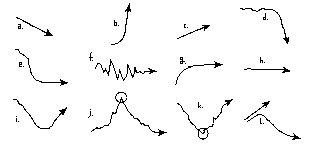| Introduction It may occur to you that "describing graphs" is not so interesting. We think just the opposite. We are positive that when you have a look at our page you will understand why. We know also that it can help in a way in your (future) business activities. We are sure that what we have put on this page can facilitate the importance and solve problems related to this activity. When you have finished doing the exercises you can check how well you did in our Answers to exercises. If some words or phrases are too tough for you, you can always check the dictionary . Helpful words and phrases: UP-verbs go up take off shoot up soar jump increase rise grow rocket improve UP-nouns an increase a rise a growth an improvement an upturn a surge an upsurge an upward trend DOWN-verbs go/come down fall fall off drop slump decline decrease plummet slip shrink DOWN-nouns a fall a decrease a decline a drop a downturn a downturn trend NO CHANGE-verbs remain stable level off stay at the same level remain constant stagnate stabilise AT THE TOP-verbs reach a peak peak top out AT THE BOTTOM-verbs reach a low point bottom out recover DEGREES OF CHANGE Adjectives: dramatic, considerable, sharp, significant, substantial, moderate, slight, Adverbs: dramatically, considerably, sharply, significantly, substantially, moderately, slightly SPEED OF CHANGE abrupt sudden rapid quick steady gradual slow PREPOSITIONS a rise from 10$ to 12$ to increase by 50% to fall by 30% an increase of 7.5 per cent over last year Exercises Exercise 1 You will see graphs below. Which graph illustrates the movement described in these sentences. 1.The market is showing some signs of growth. 2.The market is extremely volatile. 3.The pound slipped back against the dollar. 4.The Swiss franc is staging a recovery. 5.The lira lost ground slightly. 6.There's been a dramatic downturn in the market. 7.There's been an upsurge of interest in gold. 8.The share price bottomed out at 115p. 9.Sugar peaked at $400 a tonne. 10.Profits will level off at around L1 11.Sales hit an all-time low. 12.There hasn't been much movement in the price of tin.  Exercise 2 The financial press is full of expressions of change and development. Chose the correct verbs and try to connect them with appropriate graphs according to the type of change they describe: slump rise recover plunge pick up plummet drop soar bounce back take off climb rally fluctuate fall stabilise slide flatten out crash hold steady escalate decline rocket dip  Exercise 3 Read these descriptions of a company's operating figures and match them to the correct graphs. Label the graphs with the correct title. UK SALES When demand decreased at the start of the year, UK sales fell sharply. They remained steady until April, then rose again dramatically in the second quarter when the market improved. OUTPUT The decrease in overseas sales caused a dramatic drop in output at the Birmingham plant in the first quarter. There was a steady increase in the second when domestic sales improved. STOCK LEVELS There was a steady decrease in stock levels at the Headingley plant in the first quarter due to the introduction of a new inventory control system. The slight increase in the second quarter was due to the rise in output. PROFITS The profits of the plastics division have fallen steadily over the last five months due to the fall in demand and increases in production costs. The slight rise in profits last month was due to the recent price increases. PROFIT MARGIN A sudden jump in the production costs of the Sarander caused a drop in the profit margin in the first quarter. The margin remained the same in the second, due to a sharp fall in the costs of components.  Exercise 4 Study the graph (which you will see below), then complete the description given below.  In 1965, the price of New Zealand's wool ................... $1.98 per kilo. It then ......................... by 20 cents in 1966 before falling ...................... to $1.37 in 1971. There was a ....................... increase over the next two years, with the price of wool ........................ of $5.13 in 1973. From 1974 to 1978 the price ................... between a high of $3.20 and a low of $2.75, before ......................... $4.60 in 1980. After falling again to $3.60 in 1983, the price ........................... at $3.55 in 1985. | Answers to exercises |